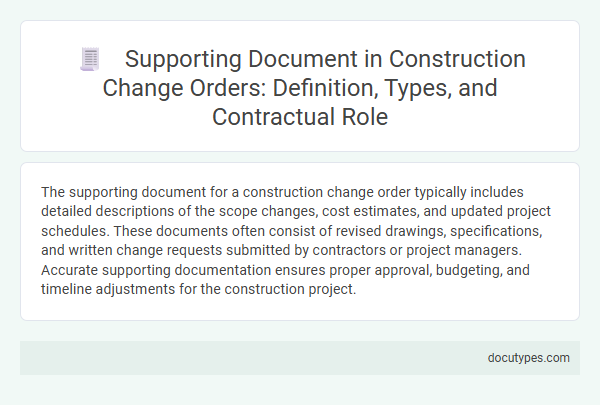The supporting document for a construction change order typically includes detailed descriptions of the scope changes, cost estimates, and updated project schedules. These documents often consist of revised drawings, specifications, and written change requests submitted by contractors or project managers. Accurate supporting documentation ensures proper approval, budgeting, and timeline adjustments for the construction project.
Introduction to Supporting Documents in Construction Change Orders
Supporting documents in construction change orders provide essential evidence for modifications made during a project. These documents validate the scope, cost, and schedule adjustments requested by contractors or clients.
Common supporting documents include change order forms, cost estimates, revised drawings, and correspondence. Proper documentation ensures transparency and reduces disputes between parties involved in the construction contract.
Definition of Supporting Documents in Construction Contracts
Supporting documents in construction contracts are essential records that validate and justify changes made to the original scope of work. These documents provide evidence for modifications, ensuring transparency and contractual compliance.
Common supporting documents include change order requests, revised drawings, cost estimates, and correspondence between parties. They serve to clarify the reasons for changes and support approvals, preventing disputes during project execution.
Importance of Supporting Documents for Change Orders
Supporting documents for a construction change order provide essential evidence and details that justify the modifications requested. These documents ensure clear communication, proper authorization, and accurate record-keeping throughout the project.
- Verification - Supporting documents verify the necessity and scope of the change, preventing disputes and misunderstandings.
- Cost Transparency - They offer detailed cost breakdowns and estimates that clarify financial impacts on the project budget.
- Legal Protection - Proper documentation safeguards all parties by providing a formal record that supports contract compliance and dispute resolution.
Common Types of Supporting Documents in Construction Projects
```htmlSupporting documents for a construction change order provide essential proof and details that justify modifications to the original contract. Common types include detailed cost estimates, revised project schedules, and updated drawings or specifications. These documents ensure transparency, accurate billing, and effective communication among all project stakeholders.
```Role of Supporting Documents in Contract Administration
What is the supporting document for a construction change order? Supporting documents provide detailed evidence and justification for modifications in the original contract scope. These documents play a crucial role in contract administration by ensuring transparency, facilitating approval processes, and preventing disputes during project execution.
Legal and Contractual Requirements for Submission
Supporting documents for a construction change order validate the modification request and ensure compliance with contract terms. These documents serve as legal evidence and form the basis for approval and payment adjustments.
- Change Order Request Form - Official form submitted to detail and describe the proposed changes in scope.
- Detailed Cost Breakdown - Itemized documentation of materials, labor, and equipment costs related to the change order.
- Contractor and Owner Approvals - Signatures or written consent from both parties confirming agreement to the change order terms.
Best Practices for Preparing Supporting Documentation
| Aspect | Details |
|---|---|
| Definition | Supporting documents for a construction change order provide evidence and justification for requested modifications to the original contract scope, cost, or schedule. |
| Common Types |
|
| Purpose | To clearly document changes, facilitate communication among parties, and support contract adjustments to prevent disputes. |
| Best Practice 1: Clarity and Detail | Include clear descriptions, scope of change, and explicit cost breakdowns to ensure transparent communication and accurate pricing. |
| Best Practice 2: Timeliness | Prepare and submit documentation promptly after identifying changes to maintain project momentum and avoid delays in approvals. |
| Best Practice 3: Consistency | Use standardized formats and templates aligned with contract requirements and company policies to ensure uniformity. |
| Best Practice 4: Verification and Support | Back documentation with verifiable data such as site photos, labor records, or vendor quotes to validate change order claims. |
| Best Practice 5: Stakeholder Review | Engage relevant parties, including project managers and clients, in reviewing supporting documents to secure timely approvals. |
| Best Practice 6: Legal and Contractual Compliance | Ensure all supporting documents comply with contractual clauses, legal requirements, and industry standards to avoid disputes. |
Impact of Insufficient Documentation on Change Orders
Supporting documents for a construction change order typically include detailed change requests, cost estimates, revised drawings, and approval signatures. These documents verify the scope, cost, and authorization of the change, ensuring clarity and mutual agreement between parties. Insufficient documentation can lead to disputed claims, project delays, and increased costs due to lack of clear evidence supporting the changes.
Digital Tools for Managing Supporting Documents
Supporting documents for a construction change order include contracts, drawings, specifications, and cost estimates that validate the requested changes. Digital tools streamline the management of these documents by enabling easy storage, retrieval, and sharing among project stakeholders.
Cloud-based platforms provide real-time access to updated change order documentation, reducing delays and errors. Construction management software organizes supporting documents, ensuring all revisions are tracked and approved efficiently. Mobile applications allow field teams to upload and review change orders instantly, enhancing communication and transparency throughout the project lifecycle.
What Is the Supporting Document for a Construction Change Order? Infographic

